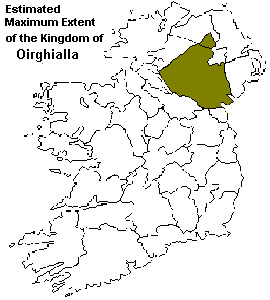Kingdom of Oriel
Airgíalla (also Airgialla, Uriel, Orial, Orgialla, Orgiall, Oryallia, Ergallia, Modern Irish Oirialla) was the name of an Irish federation and Irish kingdom which first formed around the 7th century.
The Airgíalla were a group of mainly unrelated dynasties, located in what is now central and southern Ulster, who formed a military federation, seemingly in the late 7th century. The term Airgíalla was believed to be derived from the Irish orgialla meaning "hostage of gold", but recent research suggests that it is derived from *Airgíallne, meaning "additional clientship." The term was also used to describe the Kingdom of Airgíalla.
Legendary Origins
In the beginning of the 4th century three warlike princes, called the Three Collas, sons of Eochy Doimhlein, son of Cairbre Lifeachar, legendary High King of Ireland, of the race of Eremon, made a conquest of a great part of Ulster, which they wrested from the old possessors, princes of the race of Ir, called the Clanna Rory, or Rudericians.
The Three Collas in the great Battle of Achadh Leithdheirg in Fearmuighe (also Fearnmhagh), in Dalaradia, on the borders of Down and Antrim, 331, defeated the forces of Fergus Foga, king of Ulster, who was slain; and the victors burned to the ground Emain Macha or Emania, (near the present city of Armagh,) the famous palace of the Ultonian kings, which had stood for six centuries, and had been long celebrated by the Irish bards. The place where this battle was fought is called also Carn Achy-Leth-Derg, and is now known as the parish of Aghaderg, in the barony of Iveagh, county of Down, where there still remains a huge Cairn of loose stones near Loughbrickland. The sovereignty of Ulster thus passed from the race of Ir to the race of Heremon.
The names of the three chiefs were Colla Uais, or Colla the noble, Colla Meann, or Colla the famous, and Colla da Chroich, or Colla of the two territories. Colla Uais became monarch of Ireland 327, and died in 332. The territory conquered by the three Collas comprised the present countries of Louth, Monaghan, and Armagh.
The name of Airgialla was thought to derive from the circumstance of the Collas having stipulated with the king of Ireland, for themselves and their posterity, that if any chiefs of the clan Colla should be at any time demanded as hostages, and if shackled, their fetters should be of gold: thus, from the Irish, ór, gold, and giall, a hostage, came the name orgialla.
Recent Theories
The earliest reference to the Airgíalla occours in the Annals of Tigernach under the year 677, where the death of Dunchad mac Ultan, "Ri Oigriall", is noted. However, it is suspected of being a retrospective interpolation. On the other hand, the entry in the Annals of Ulster under the year 697 which lists Mael Fothataig mac Mael Dub as "Rex na nAirgialla" may indeed be genuine. Both Mael Fothatag and his son, Eochu Lemnae (died 704) is listed as one of the guarantors of the "Cáin Adomnáin" in 697. Thus it is believed that the Airgíalla were probably in existence as an entity by then, or certainly by the opening years of the 8th century.
The Nine Kingdoms of Airgíalla
The over-kingdom of Airgíalla was itself composed of nine sub-kingdoms, named after their ruling dynasties. They were
- Ui Thuirtri
- Ui Meic Cairthinn
- Ui Fhiachrach Arda Sratha
- Ui Moccu Uais
- Ui Chremthainn
- Ui Meith
- Ind Airthir
- Mugdorna
- Ui Cruinn
The most powerful among them was the Ui Moccu Uais; one of the lesser Airgíalla was its offshoot, the Ui Meic Cairthinn.
However in general it can be shown that the origin legend was composed in the second quarter of the 8th century to seal their alliance with the Uí Néill (see Cenél Conaill and Cenél nEógain).
It has since being shown that the Airgíalla were not a kindred but a federation, whose members were of diverse origins, resulting in the kingship of the kingdom passing from one unrelated dynasty to another.
Sources
- The Kingship and Landscape of Tara, ed. Edel Bhreathnach, 2005; ISBN 1851829547
- "A Hidden Ulster" by Pádraigín Ní Ullacháin, 2003, Four Courts Press 1-85182-685-8 & 1-85182-738-2.
- "Songs From A Hidden Ulster", broadcast by RTÉ Radio 1 in 2006, presented by Pádraigín Ní Ullacháin.
